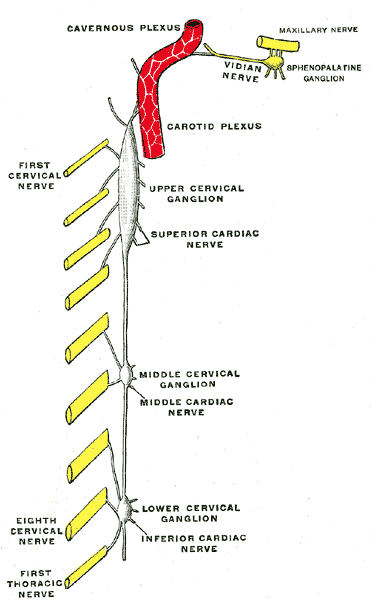
Anatomy
Head and Neck
Regarding Horner's syndrome, which of the following statements is CORRECT:
Answer:
Horner's syndrome is characterised by pupil constriction, partial ptosis and anhidrosis.Sympathetic Trunk
Anatomy / Head and Neck / Neck
Last Updated: 11th April 2019
The sympathetic trunks are two parallel cords that run from the base of the skull to the coccyx. Along the way they are punctuated by ganglia, collections of neuronal cell bodies outside of the CNS. The cervical part of the sympathetic trunk is anterior to the longus colli and longus capitis muscles and posterior to the common carotid artery in the carotid sheath.
There are three ganglia along the course of the sympathetic trunk in the cervical region within which ascending preganglionic sympathetic fibres from upper thoracic spinal cord levels synapse with postganglionic sympathetic fibres. The postganglionic fibres are distributed from these ganglia in branches, called grey rami communicantes, which connect with cervical spinal nerves C1 - C8.

Cervical Ganglia of the Sympathetic Trunk. (Image by Henry Vandyke Carter [Public domain])
Superior Cervical Ganglion
The superior cervical ganglion is responsible for sympathetic innervation to the structures in the head and neck. The superior cervical ganglion lies in the area of vertebrae C1 - C2 and has branches to:
- the internal and external carotid arteries
- the cervical spinal nerves C1 - C4
- the pharynx
- the heart
Middle Cervical Ganglion
The middle cervical ganglion lies in the area of vertebra C6 and has branches to:
- cervical spinal nerves C5 - C6
- the heart
Inferior Cervical Ganglion
The inferior cervical ganglion lies in the area of vertebra C7 (anterior to the neck of rib I, posterior to the first part of the subclavian artery), combines with the first thoracic ganglion to form the cervicothoracic ganglion and has branches to:
- spinal nerves C7 - T1
- the vertebral and subclavian artery
- the heart
This ganglion may also receive white rami communicantes from thoracic spinal nerves T1 - T2.
Horner's Syndrome
The sympathetic fibres can be stretched or damage along their course and if unilaterally disturbed may produce Horner's syndrome, a triad of partial ptosis (due to paralysis of the superior tarsal muscle), miosis (due to paralysis of the dilator pupillae muscle) and anhidrosis (due to loss of innervation to the sweat glands).
Secondary changes may also include ipsilateral vasodilation (due to loss of sympathetic control of subcutaneous blood vessels) and enophthalmos (due to paralysis of the orbitalis muscle).
Possible causes of Horner's syndrome include:
- Apical lung tumour (Pancoast's tumour) eroding the cervicothoracic ganglion
- Thyroid carcinoma
- Penetrating injury to neck
- Lymphadenopathy
- Cervical rib
- Injury to carotid arteries
Report A Problem
Is there something wrong with this question? Let us know and we’ll fix it as soon as possible.
Loading Form...
- Biochemistry
- Blood Gases
- Haematology
| Biochemistry | Normal Value |
|---|---|
| Sodium | 135 – 145 mmol/l |
| Potassium | 3.0 – 4.5 mmol/l |
| Urea | 2.5 – 7.5 mmol/l |
| Glucose | 3.5 – 5.0 mmol/l |
| Creatinine | 35 – 135 μmol/l |
| Alanine Aminotransferase (ALT) | 5 – 35 U/l |
| Gamma-glutamyl Transferase (GGT) | < 65 U/l |
| Alkaline Phosphatase (ALP) | 30 – 135 U/l |
| Aspartate Aminotransferase (AST) | < 40 U/l |
| Total Protein | 60 – 80 g/l |
| Albumin | 35 – 50 g/l |
| Globulin | 2.4 – 3.5 g/dl |
| Amylase | < 70 U/l |
| Total Bilirubin | 3 – 17 μmol/l |
| Calcium | 2.1 – 2.5 mmol/l |
| Chloride | 95 – 105 mmol/l |
| Phosphate | 0.8 – 1.4 mmol/l |
| Haematology | Normal Value |
|---|---|
| Haemoglobin | 11.5 – 16.6 g/dl |
| White Blood Cells | 4.0 – 11.0 x 109/l |
| Platelets | 150 – 450 x 109/l |
| MCV | 80 – 96 fl |
| MCHC | 32 – 36 g/dl |
| Neutrophils | 2.0 – 7.5 x 109/l |
| Lymphocytes | 1.5 – 4.0 x 109/l |
| Monocytes | 0.3 – 1.0 x 109/l |
| Eosinophils | 0.1 – 0.5 x 109/l |
| Basophils | < 0.2 x 109/l |
| Reticulocytes | < 2% |
| Haematocrit | 0.35 – 0.49 |
| Red Cell Distribution Width | 11 – 15% |
| Blood Gases | Normal Value |
|---|---|
| pH | 7.35 – 7.45 |
| pO2 | 11 – 14 kPa |
| pCO2 | 4.5 – 6.0 kPa |
| Base Excess | -2 – +2 mmol/l |
| Bicarbonate | 24 – 30 mmol/l |
| Lactate | < 2 mmol/l |

